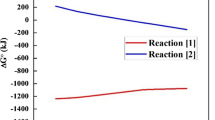Summary
A practical process has been developed for the preparation of high-purity, ductile columbium metal. The process consists of reducing Cb2O5 with aluminum powder in a “bomb”-type reduction. The massive columbium contains approximately 2 wt % Al and 0.8 wt % O2. These impurities, along with nitrogen and iron, can be satisfactorily removed in subsequent treatments by volatilization. Much of the impurities in the as-reduced columbium can be removed by heating in vacuum to 2000°C for 8 hr, leaving a sponge. These impurities may also be largely removed by heating for a shorter time at 2200°C; however, some loss of the columbium is encountered. Heating to 1800°C for 8 hr was found to be less efficient for impurity removal.
The purified columbium sponge prepared by heating to 2000 or 2200°C can be converted to massive, ductile metal by non-consumable arc melting. Further purification can be achieved by electron beam melting of the sponge.
The direct vacuum arc melting of the as-reduced material was found to be only partially effective for impurity removal. A duplex melting scheme in which the vacuum arc-cast ingot was remelted in an electron beam furnace yielded high-purity ductile columbium. Electron beam melting of the as-reduced columbium metal offers possibilities in a furnace designed to eliminate interference from the moderate amounts of aluminum and other volatiles present.
Similar content being viewed by others
References
W. H. Dennis: Metallurgy of the Non-Ferrous Metals, Pitman (New York), 1961, p. 643.
E. M. Sherwood: Rare Metals Handbook, ed. by C. A. Hampel, Reinhold (London), 1961, pp. 149–177.
T. E. Tietz and J. W. Wilson: Behavior and Properties of Refractory Metals, Stanford University Press (Stanford, Calif.), 1965, p. 102.
R. J. Jones: Mines Branch Mem. Ser. No. 135 (1957), Canadian Dept. of Mines and Technical Surveys, Ottawa, Ont., Canada.
C. W. Balke: Ind. Eng. Chem., 1935, vol. 27, pp. 1166–1169.
E. S. Candidus and J. C. Simons, Jr.: Fifth National Symposium on Vacuum Technology Transactions, Pergamon Press (New York), 1959, pp. 86–88.
H. R. Smith: Vacuum Metallurgy, ed. by R. F. Bunshah, Reinhold (London), 1958, pp. 221–235.
H. R. Smith, C. d’A. Hunt, and C. W. Hanks: Reactive Metals, ed. by W. R. Clough, Interscience (New York), 1959.
W. E. Dennis and A. F. Adamson: U.K.A.E.A. Report R&DB(C)/TN-92 (1954).
C K. Gupta and P. J. Jena: Trans. Met. Soc. AIME, 1964, vol. 230, no. 6, p. 1433.
H. Goldschmidt and C. Vauten: J. Soc. Chem. Ind., 1898, vol. 19, p. 543.
W. Von Bolton: Z. Elektrochem., 1907, vol. 13, pp. 145–149.
L. F. Mondolfo: US Patent #2,803,536 (1957).
W. J. Hurford: USAEC Rept. TID-5061 (1952), Office of Technical Services, Washington, D. C.
D. T. Peterson, W. E. Krupp, and F. A. Schmidt: J. Less Common Metals, 1964, vol. 7, pp. 288–295.
Author information
Authors and Affiliations
Rights and permissions
About this article
Cite this article
Wilhelm, H.A., Schmidt, F.A. & Ellis, T.G. Columbium metal by the aluminothermic reduction of Cb2O5. JOM 18, 1303–1308 (1966). https://doi.org/10.1007/BF03378518
Published:
Issue Date:
DOI: https://doi.org/10.1007/BF03378518




